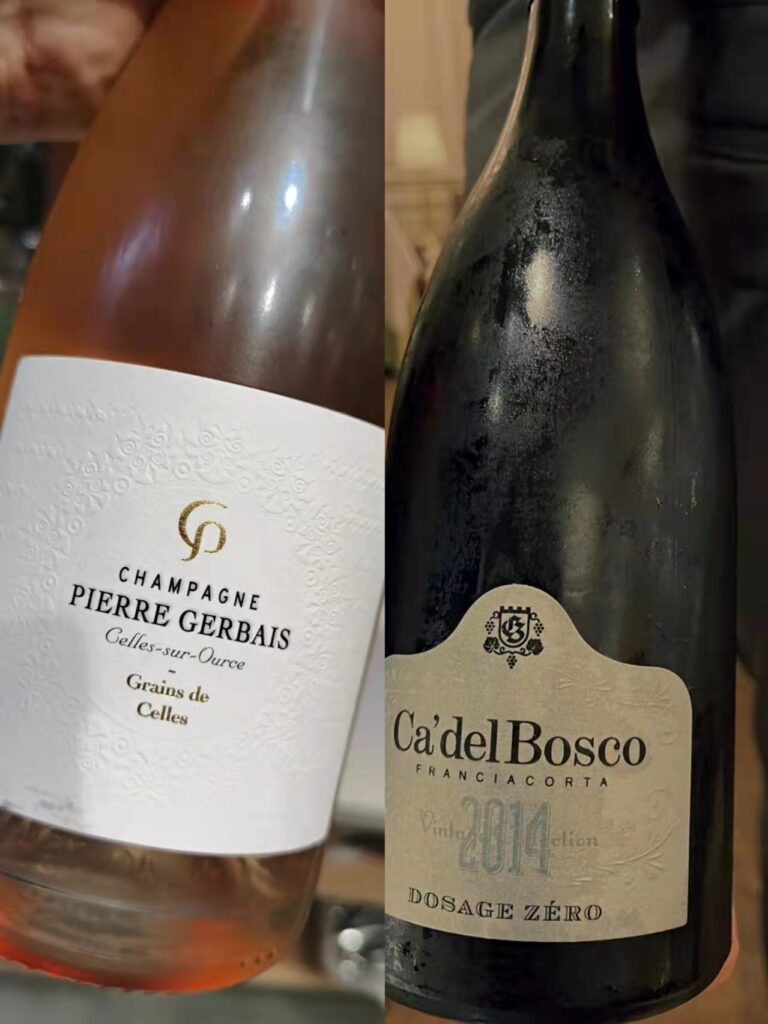
Pierre Gerbais NV Champagne Grains de Celles Rosé 95
A fourth-generation estate now very capably run by the likeable and passionate Aureline Gerbais, this is one of those small Champagne estates the quality of the wines of which far outweighs their fame. Located in the Aube in the quaint town of Celles-sur-Ource, this beautiful Rosé bubbly is exactly the same wine as the non-rosé Champagne but made with 10% Coteaux Champenois Pinot Noir so as to turn it into a pink bubbly. One particularity about the Grains de Celles duo is the presence of Pinot Blanc in the blend, a rarity in Champagne where the vast majority of bubblies are made with the big three of Pinot Noir, Pinot Meunier and Chardonnay. The Pierre Gerbais NV Champagne Grains de Celles Rosé is a Rosé d’assemblage, an Extra Brut that is a blend of 45% Pinot Noir, 22.5% Chardonnay and 22.5% Pinot Blanc; the roughly thirty years old vines of which are cultivated in a certified sustainable manner (Ampelos certification). Bright salmon-pink in colour, this delightful bubbly offers aromas and flavours of small wild strawberries, herbs, minerals and violet. It lingers long on the suave but vibrant finish, boasting a youthfully round but chewy texture and a multilayered quality that just builds and builds. Extremely well-done here, really: this is the best NV Rosé Champagne I have tried all year. Drinking window: now-2026.
Ca’ del Bosco 2014 Franciacorta 2014 Vintage Collection Dosage Zéro 95
Founded in 1969, but taken to its current lofty quality levels much later by Maurizio Zanella, Ca’ del Bosco is one of Italy’s top thirty or so wine estates and certainly either the best or at no worst one of the two best producers of Italian bubblies made by secondary fermentation in the bottle in the manner of Champagne. Though certainly most famous for its iconic Annamaria Clementi bottling, the top-of-the line Franciacorta that is named after Zanella’s mother, real Italian wine insiders and lovers know that the estate’s other truly amazingly good wine is the Dosage Zéro. Not that there is a bad wine anywhere in the line-up (excellent still wines included), but the Dosage Zéro is a true marvel of quality in every vintage, and though it offers a very different drinking experience, it comes at a fraction of the price of the Annamaria Clementi. The great thing about the Dosage Zéro is not just its complexity and richness without every being heavy or flabby, but the fact that it is magically well-balanced, never coming across as angular or shrill as far too many Extra Brut bubblies do the world over. The Ca’ del Bosco 2014 Franciacorta 2014 Vintage Collection Dosage Zéro is a paragon of balance and depth. Bright straw yellow, with a persistent bead of energetic small bubbles, it combines noteworthy fragrance and purity in its aromas and flavours of white stone fruit, fresh citrus fruit, sweet spices, menthol and herbs. The finish is suave, extremely long, and complex. The Dosage Zéro is singular in that its blend is characterized by a hefty presence of Pinot Blanc, the presence of which, while rare in other world bubblies such as for example Champagne, is not so uncommon in Franciacorta where the grape has been historically planted to add freshness and elegance to the finished wines (by contrast, and also differently from Champagne, Pinot Meunier is not much planted in Franciacorta). But even so, only about 5% of the total vineyard area in Franciacorta is planted to Pinot Blanc, and so it is not so common to find it in even Franciacortas. There is no doubt that it is Ca’ del Bosco that has among the best and oldest vineyards of this variety in the denomination. The 2014 Dosage Zéro is a blend of 65% Chardonnay, 22% Pinot Noir and 13% Pinot Blanc, sourced from eleven Chardonnay vineyards of 34 years of age on average, six vineyards of Pinot Nero averaging 26 years of age, and two vineyards of Pinot Blanc also averaging twenty-six years of age (note that this blend has changed in recent years when other vineyards have been added to the fold slightly changing the average age of the vines: a later vintage of the Dosage Zéro, such as for example the 2016, was made with grapes picked in eighteen Chardonnay vineyards averaging 32 years of age, seven Pinot Noir vineyards averaging 30 years of age and three Pinot Blanc vineyards averaging 28 years of age). The grapes are picked and chilled and then put through Ca’ del Bosco’s famous “grape spa”, a rather large machine that incorporates a bunch washing and jet spray system made up of three soaking vats and a drying tunnel (trust me, it’s actually quite the thing to see at work). Grapes are crushed in the absence of oxygen, and the base wine musts fermented and matured in small oak barrels for five months, then gravity-racked into maturation tanks. The final 2014 product is a cuvée of eighteen different Chardonnay, Pinot Nero and Pinot Blanc base wines. Disgorgement occurs in absence of oxygen thanks to a specific system designed and patented by Ca’ del Bosco, aimed at ensuring freshness and longevity, but also to lessen the use of added sulfites at time of bottling. Drinking window: now-2030.

 中文
中文



